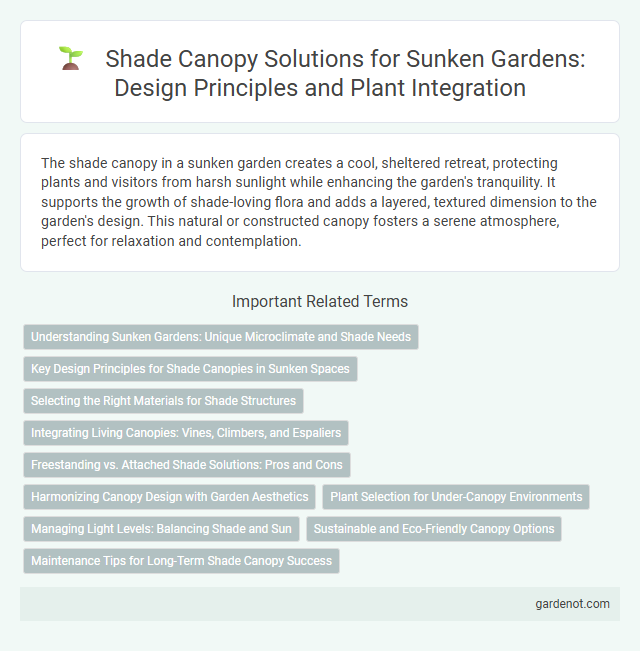The shade canopy in a sunken garden creates a cool, sheltered retreat, protecting plants and visitors from harsh sunlight while enhancing the garden's tranquility. It supports the growth of shade-loving flora and adds a layered, textured dimension to the garden's design. This natural or constructed canopy fosters a serene atmosphere, perfect for relaxation and contemplation.
Understanding Sunken Gardens: Unique Microclimate and Shade Needs
Sunken gardens create a unique microclimate by being recessed below ground level, which naturally moderates temperature and humidity. Shade canopies are essential in these gardens to protect delicate plants from excessive sunlight, maintaining an ideal environment for moisture-loving species. Understanding the interaction between the shade canopy and the sunken garden's microclimate helps optimize plant health and growth.
Key Design Principles for Shade Canopies in Sunken Spaces
Shade canopies in sunken garden spaces must prioritize structural stability and moisture resistance to withstand lower elevation challenges such as water accumulation and limited airflow. Optimal design incorporates breathable, UV-resistant fabrics paired with sturdy, corrosion-proof frames to ensure durability and user comfort. Integrating natural ventilation pathways and gradient placement enhances airflow while maintaining effective shade coverage throughout the day.
Selecting the Right Materials for Shade Structures
Choosing durable materials such as marine-grade aluminum or galvanized steel ensures long-lasting support for shade canopies in sunken gardens. UV-resistant fabrics like solution-dyed acrylic provide effective sun protection while maintaining color fastness under prolonged exposure. Proper material selection enhances structural integrity and comfort, promoting an inviting shaded retreat in the garden.
Integrating Living Canopies: Vines, Climbers, and Espaliers
Integrating living canopies such as vines, climbers, and espaliers into the sunken garden enhances natural shade while promoting biodiversity and air quality. These vertical plantings create dynamic, green walls that regulate temperature and provide seasonal interest with varying leaf textures and colors. Employing species adapted to the local climate ensures sustainability and minimal maintenance, making shade canopies both functional and aesthetically pleasing.
Freestanding vs. Attached Shade Solutions: Pros and Cons
Freestanding shade canopies in sunken gardens offer flexible placement and easy relocation, ideal for creating versatile shaded areas without structural dependency. Attached shade solutions provide a more permanent and stable option, maximizing space by utilizing existing walls or frameworks, but they can limit design adaptability and require structural support. Choosing between freestanding and attached shade canopies depends on desired flexibility, installation complexity, and integration with garden architecture.
Harmonizing Canopy Design with Garden Aesthetics
Harmonizing shade canopy design with sunken garden aesthetics involves selecting materials and colors that complement the natural landscape and existing flora. Incorporating organic shapes and natural textures in the canopy structure enhances the visual coherence and creates a serene, inviting atmosphere. Thoughtful integration of light-filtering fabrics or lattices ensures optimal sunlight diffusion while maintaining the garden's tranquil ambiance.
Plant Selection for Under-Canopy Environments
Selecting shade-tolerant plants such as hostas, ferns, and astilbes enhances the biodiversity and aesthetic appeal under a shade canopy in a sunken garden. These plants thrive in low-light conditions, ensuring lush foliage and vibrant textures without competing for sunlight. Incorporating native shade-loving species supports local ecosystems while maintaining soil health and moisture retention.
Managing Light Levels: Balancing Shade and Sun
Shade canopies in sunken gardens play a crucial role in managing light levels by filtering sunlight to create a balanced environment that supports diverse plant growth. Strategic placement and material selection of canopies optimize the diffusion of natural light, preventing excessive sun exposure while maintaining adequate brightness for photosynthesis. This balance enhances the garden's microclimate, promoting plant health and visitor comfort simultaneously.
Sustainable and Eco-Friendly Canopy Options
Sustainable shade canopies in sunken gardens utilize eco-friendly materials such as bamboo, recycled metal, and organic fabrics to reduce environmental impact. These canopies promote natural cooling by enhancing airflow and minimizing heat absorption, lowering energy consumption. Incorporating solar panels or rainwater collection systems within the canopy design supports renewable energy use and water conservation.
Maintenance Tips for Long-Term Shade Canopy Success
Regular inspection of the shade canopy for tears or sagging fabric ensures optimal protection from sun damage and prolongs its lifespan. Cleaning the canopy with mild soap and water prevents mold and mildew buildup while avoiding harsh chemicals that can deteriorate the material. Secure anchoring and seasonal adjustments accommodate weather changes, enhancing structural stability and overall durability.
Shade canopy Infographic

 gardenot.com
gardenot.com